The Smithsonian Institution’s National Museum of African American History and Culture (NMAAHC) wanted to tell the story of African American philanthropy, viewed through the lens of the generous support given to bring the National Mall’s newest Smithsonian museum to life. The exhibit needed to celebrate named supporters, demonstrate the impact of their gifts, and inspire others to contribute to NMAAHC’s future.
In close partnership with design partner Belle & Wissell, we worked closely with advancement and exhibit teams to design a data-driven system that would be engaging, meaningful, and let the donors be the heroes of the story. As the only digital exhibit in a voluminous, high-traffic space, the exhibit needed to command attention, reward exploration, and give existing donors their moment in the spotlight. The end result was the Digital Donor Experience, a series of dynamic data visualizations that demonstrate how all of the individual donations came together to form a “quilt” of support, where the sum of the parts was truly greater than the whole. A mix of interactive and CMS-driven content are presented in a striking physical layout, evoking the patchwork nature of the exhibit theme.
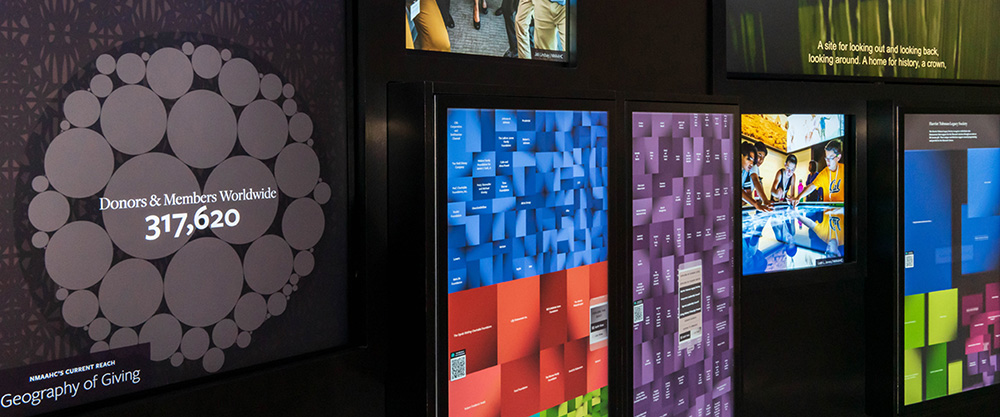
Individual contributions to the NMAAHC are critical for its success and need to be duly celebrated and showcased. However, it is in the amalgamation of these many gifts that great challenges are surmounted and lasting sustainability is achieved. Our vision for the Digital Donor Experience focuses on how the collective giving of a myriad of unique donors coalesces into a strong, resilient, and powerfully enabling fabric of support.
The Donor Quilt is a metaphor that expresses the idea that the whole is greater than the sum of its individual parts. It is simultaneously a layout mechanism, a means of navigation, a data visualization system, and a visual treatment that evokes a literal patchwork of individuals coming together to form a unified network. The Donor Quilt is central to the UI and influences the visual design and presentation of information, as well as the physical design of the installation. Much like a real quilt, the Digital Donor Wall is filled with captivating color and pattern to invite interaction and bring the story of African American philanthropy to life.
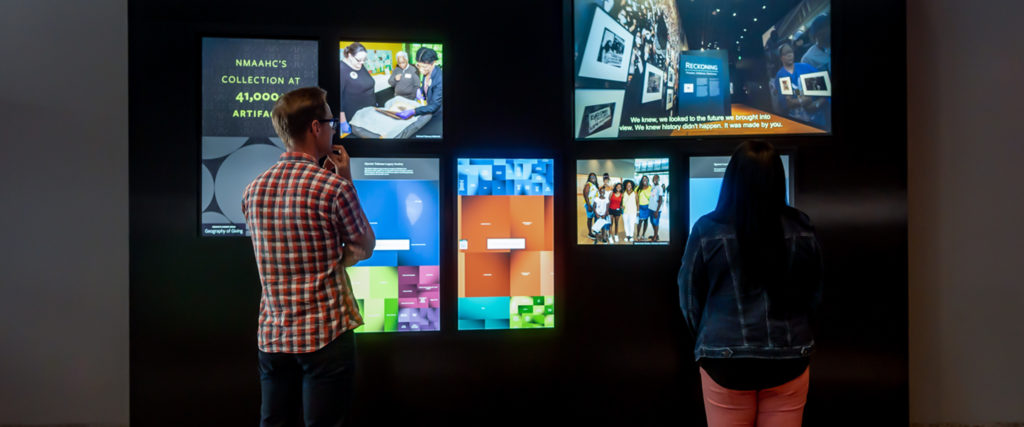
Our approach considers two audiences – donors, and those who have yet to donate. The former are proud of their contributions and want to feel recognized; we look to convince the latter of the importance of philanthropy. The exhibit inspires both audiences to donate, whether for the first time or with an additional gift. We always design for two kinds of users – those who like to engage and those who prefer passive consumption. Our approach targets both simultaneously by avoiding a monolithic system.
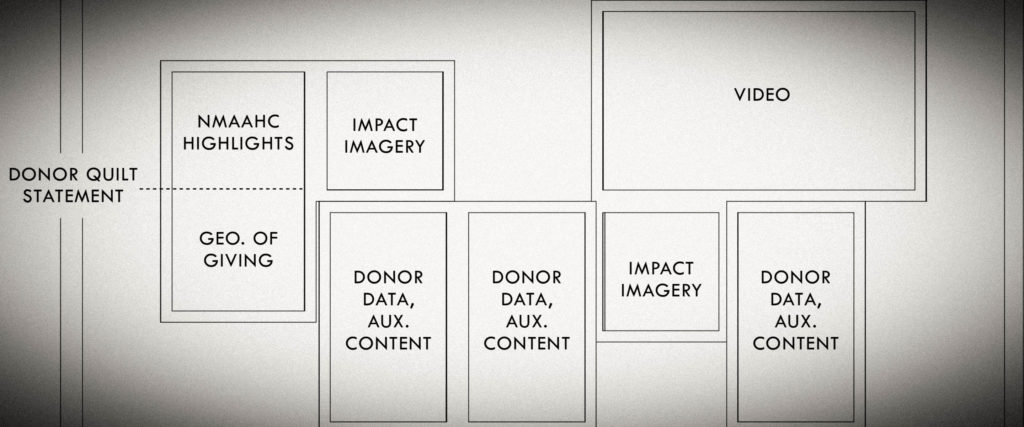
The physical design of the exhibit reflects a quilt through an assemblage of differently-sized and oriented screens. Instead of a single experience that is either resting or actively engaged, our approach simultaneously serves individuals/groups that wish to interact and those that simply wish to stand back and observe. The distinctly non-rectilinear format adds visual interest and texture and supports socially-distanced and ADA-compliant interaction. This approach is also significantly less complicated and more cost-effective to implement than a multi-monitor, multi-user, multi-touch wall, while still achieving high visual impact and ease of use.
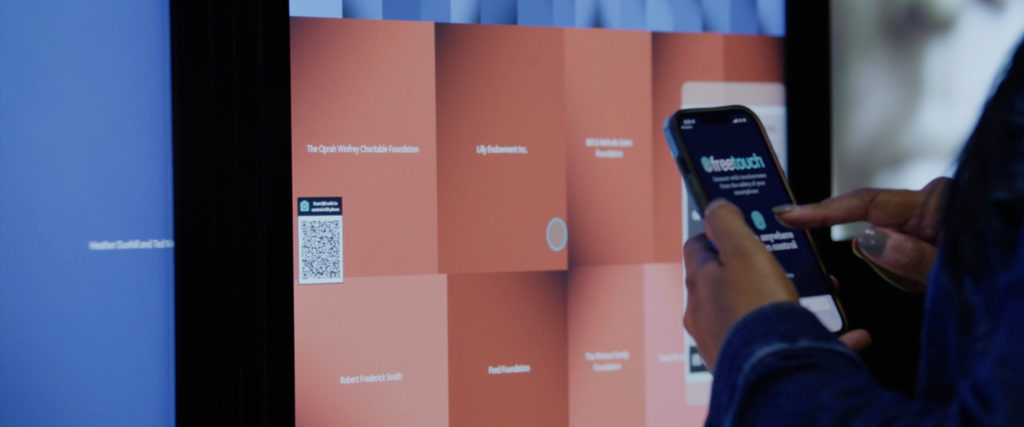
In pandemic and post-pandemic times, best practices for in-person interaction have changed. Where possible, we positioned displays to enable socially-distanced direct interaction. To accommodate touch-averse users, we leveraged Freetouch, our proprietary software-based touchless software. Users wishing to interact touchlessly scan the onscreen QR code (no app download required, no need to join the local WiFi network, GDPR/CCPA compliant). The system spawns a cursor that serves as a proxy for their touch. The user’s phone behaves as a virtual trackpad and keyboard, enabling them to interact with the displays from a safe distance.
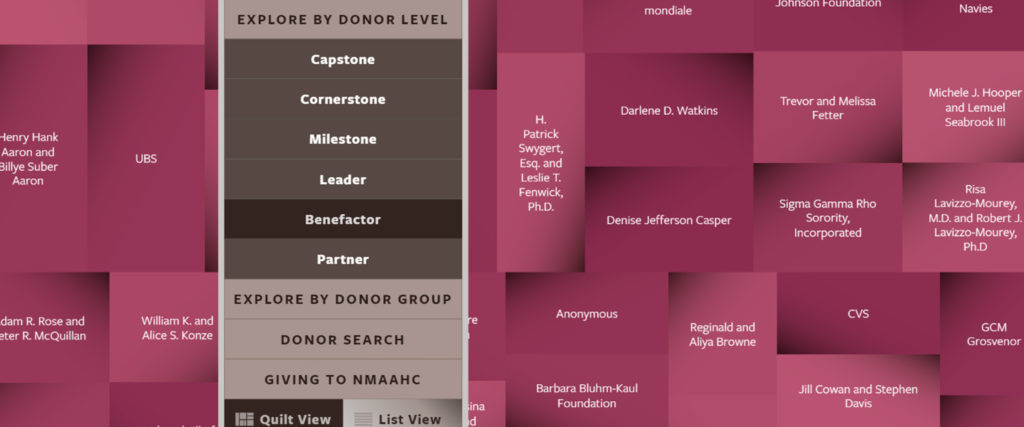
A dynamic, scalable, and highly-engaging user interface is critical to bringing large amounts of information and data to life. We designed an interface that invites interaction, rewards exploration, and showcases donors in a highly unique way, all while digitally bringing to life the central idea of individual donations coming together to create a powerful network of support.

The Donor Quilt is, at its core, a treemap. Treemaps are ideal for displaying large amounts of hierarchically structured (tree-structured) data. The space in the visualization is split up into rectangles that are sized and ordered by a quantitative variable. The shape of each rectangle is arbitrary, but the size is directly influenced by the value it represents. In the Donor Quilt, each rectangle (or donor quilt square) always represents a single donor.
In this approach, the content is the interface. Colorful, responsive, and infinitely reconfigurable, the filterable and searchable Donor Quilt lets visitors create unique quilts as they dive deeply into the roots of African American philanthropy.
A related data visualization approaches donor locations in a playful way, rethinking the need to use a map-based view to show global support. Constantly animating and refreshing, it succinctly summarizes and highlights donor geography to give every donor’s home state and/or country its moment on the big screen.
National Museum of African American History and Culture